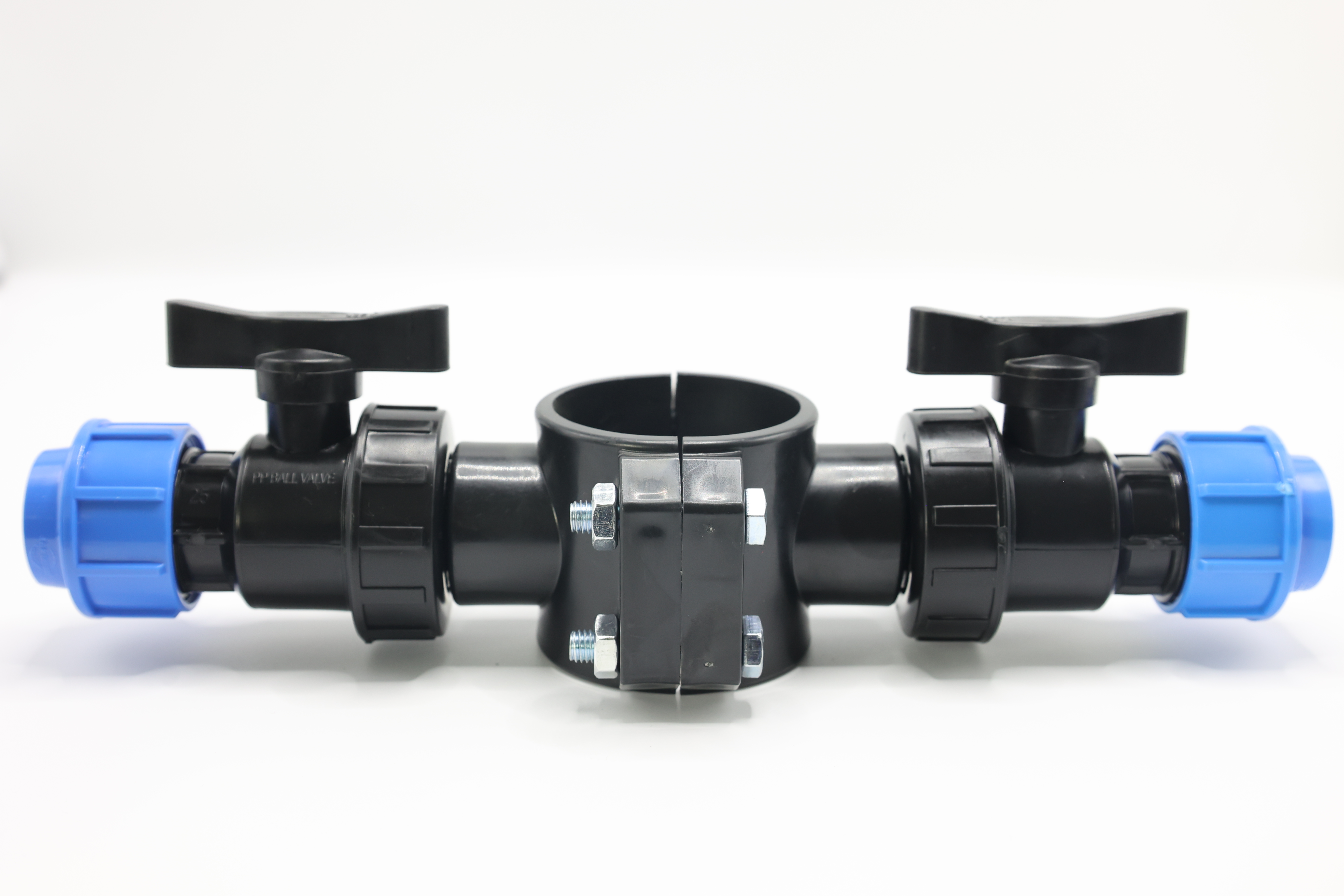Enhancing Irrigation Efficiency with Saddle Clamps
Understanding the Role of Saddle Clamps in Modern Farming
Saddle clamps serve as critical connectors in agricultural water systems, enabling farmers to create branch lines without drilling or complex tools. Their non-invasive design preserves pipeline integrity while allowing precise adjustments to water delivery.
Supporting Reliable Water Distribution Across Fields
These fittings maintain consistent pressure in irrigation networks, preventing flow fluctuations that stress crops. Field tests show farms using saddle clamps achieve 12–18% more uniform soil moisture levels compared to traditional clamped joints.
Seamless Integration with Drip and Sprinkler Systems
Modern saddle clamps feature standardized thread patterns compatible with major irrigation brands' emitters and nozzles. This interoperability allows growers to retrofit existing systems without replacing entire pipe networks.
Case Study: Improved Crop Yields Through Stable Water Flow
A 2023 study of potato farms in arid regions found that combining saddle clamps with drip irrigation boosted yields by 25–30 tons per hectare while reducing water use by 20%. Farmers attributed these gains to the clamps' ability to maintain stable root-zone hydration during peak growth phases.
Enabling Automation and Compatibility with Smart Irrigation
Leading manufacturers now produce saddle clamps with embedded sensors that interface with IoT irrigation controllers. These smart fittings automatically adjust flow rates based on soil moisture data, helping farms meet precise crop water requirements without manual intervention.
Reducing Water Loss with Leak-Proof Saddle Clamp Design
Secure Sealing Technology for Preventing Pipeline Leaks
Saddle clamps work by combining compression gaskets with materials that resist corrosion, creating those tight seals needed at pipe connections. Threaded connectors tend to break down when soil shifts around them, but saddle clamps have this wraparound shape that distributes pressure evenly across the joint, stopping water from leaking out even on uneven farmland. The real benefit here is fighting against one of the biggest problems in irrigation systems these days micro leaks that nobody notices until there's significant water loss happening right under our noses at every connection point.
Water Conservation Data: Reducing Field Leakage by Up to 30%
Field trials demonstrate saddle clamps reduce annual water loss by 27–30% compared to slip-fit PVC joints. A 2024 analysis of drip irrigation systems in arid climates found farms using saddle clamps conserved 8.7 acre-feet of water per season—enough to irrigate 12 additional acres of row crops.
Traditional Fittings vs. Saddle Clamps: A Comparative Analysis
| Factor | Traditional Slip-Fit Fittings | Leak-Proof Saddle Clamps |
|---|---|---|
| Avg. Leak Rate | 12-18 GPH | 0.5-2 GPH |
| Installation Time | 45-60 minutes (epoxy curing) | <15 minutes |
| Maintenance Intervals | Annual joint inspections | 5-7 year replacement |
| Frost Heave Resistance | 62% failure rate after 3 cycles | 94% retention rate |
Addressing the Industry Paradox: High Leaks Despite Advanced Pumps
While farms invest in $25k+ variable-speed pumps, 38% of water loss still occurs at pipe junctions (USDA 2023). Saddle clamps resolve this disconnect by providing pump-compatible fittings that maintain pressure integrity up to 125 PSI—eliminating the bottleneck between high-efficiency water delivery and leak-prone infrastructure.
Cost-Effectiveness and Long-Term Savings in Farm Water Infrastructure
Fast, Cost-Efficient Installation for Agricultural Setups
Saddle clamps make installing irrigation systems much easier since they get rid of the need for complicated welding jobs or fancy equipment. When farmers switch from old school tapping techniques to these clamps, they typically save between 40 and 60 percent on labor expenses. All that's needed are simple hand tools such as wrenches to attach those branch lines. According to a recent look at agricultural infrastructure from 2024, operations that adopted saddle clamps managed to finish their pipe work three times quicker during those crucial planting periods. This speed helps avoid costly delays which can mean losing anywhere from $18 to $32 worth of crop value per acre when things fall behind schedule.
Lower Maintenance Costs and Minimized System Downtime
PVC saddle clamps with their corrosion resistant design can cut down on yearly maintenance costs by as much as three quarters compared to traditional options. Metal versions tend to accumulate minerals over time, something that leads to about two thirds of all clogging problems in irrigation systems based on what USDA research has found. Farmers who switched to these plastic fittings have noticed dramatically fewer breakdowns needing urgent attention during those five year spans. This reliability helps maintain regular watering schedules which matters a lot when growing delicate plants such as lettuce and various berry types where consistent moisture levels are absolutely essential for good harvests.
Affordability Compared to Mechanical Tapping Saddles
At $2.50–$4.80 per unit, PVC saddle clamps cost 83% less than mechanical tapping saddles while providing equivalent pressure ratings (up to 125 PSI). Large-scale water infrastructure analyses demonstrate a 14-month ROI for farms converting to saddle clamp systems, with material savings exceeding $1,200 per mile of irrigation piping over decade-long deployments.
Durability and Environmental Resistance of PVC Saddle Clamps
UV and Weather-Resistant Construction for Longevity
The structural integrity of PVC saddle clamps holds up really well even when faced with harsh weather thanks to their special UV stabilized formula. Tests indicate these parts can handle temperature extremes ranging between minus 40 degrees Celsius all the way up to 80 degrees Celsius without breaking down under UV light. This gives them a real edge compared to metals which tend to rust away or rubber components that eventually develop cracks. According to recent research published in the 2024 report on polymer durability, UV resistant PVC manages to keep about 95 percent of its original tensile strength after sitting out in the sun for a full decade. That's actually around 40 percent better than what we see with regular plastics.
Performance Under Continuous Soil and Moisture Exposure
PVC's resistance to chemicals makes it great for saddle clamps used in underground irrigation systems. Galvanized steel just isn't cut out for this job since it reacts badly with fertilizers and salt in the soil, which leads to those annoying mineral deposits building up inside the pipes over time. Some actual field tests have shown that these PVC fittings can cut down on maintenance expenses by around 30 percent after five years, and that's pretty impressive when we're talking about areas prone to flooding where parts might be sitting underwater for months at a stretch.
Case Study: Reliability in Arid and Saline Agricultural Zones
A 2023 analysis of 42 farms using PVC saddle clamps in Morocco's Draa River Basin revealed zero clamp failures despite 8.5 dS/m salinity levels and 45°C average temperatures. Over three growing seasons, farmers reported:
- 65% fewer pipeline repairs
- 18% higher water delivery consistency
- 22% lower annual infrastructure costs
The study concluded PVC's non-porous surface prevented salt crystallization—a common failure point for metal clamps in high-evaporation zones.
Simple Installation and Labor Efficiency in Field Applications
Modern agricultural operations demand solutions that minimize labor intensity while maximizing operational uptime. Saddle clamps address these needs through innovative engineering designed for field-ready deployment.
Minimal Tools Required for On-Site Saddle Assembly
Traditional mechanical saddles need all sorts of specialized gear like pipe threading tools and torque wrenches, but PVC saddle clamps work differently. They rely on basic compression seal tech instead. Most field workers can get branch lines installed using just three things: a hole saw, a regular screwdriver, and some lubricant. These are items that tend to be lying around in pretty much every farm workshop anyway. Irrigation experts have looked into this stuff and found something interesting. When farms switch to these simpler tools for installation, they actually save about 23% on setup costs upfront when compared to going with metal options. Makes sense when you think about it.
No Specialized Skills Needed for Branch Line Connections
The clamp's split-ring design enables installation by workers without plumbing certifications. Farmers report successful deployments after less than 20 minutes of training, as the process involves three intuitive steps:
- Positioning the clamp around pre-drilled mainline pipes
- Inserting lateral line connectors
- Tightening bolts to manufacturer-specified hand-tightness
Time-Saving Advantages During Critical Planting Periods
Field trials demonstrate saddle clamp installations consume 65% less labor time than welded or glued joints. During peak planting windows, this efficiency gain allows farms to complete irrigation expansions 2–3 days faster—a critical advantage when soil moisture conditions are optimal for 72-hour germination windows.
Rapid Deployment Without System Shutdown
The non-invasive installation method eliminates the need for draining pipelines, special shutdown protocols, or post-installation pressure testing. This enables continuous irrigation during clamp deployments, as validated in arid-region field tests showing zero water disruption during lateral line additions.
FAQ
What are the benefits of using saddle clamps in irrigation systems?
Saddle clamps allow for easy installation without complex tools, maintain pipeline integrity, and reduce water leakage. They are effective in ensuring uniform soil moisture and reducing maintenance costs.
How do saddle clamps improve water conservation?
Saddle clamps feature a leak-proof design, reducing water loss by 27-30% compared to traditional fittings. This allows for more efficient water use, conserving significant amounts of water over time.
Can saddle clamps be used with existing irrigation systems?
Yes, modern saddle clamps are designed to be compatible with major irrigation brands, enabling seamless integration without the need for replacing existing pipes.
What are the cost savings associated with using saddle clamps?
Saddle clamps reduce installation and maintenance costs, with a return on investment often observed within 14 months. They are significantly cheaper than other mechanical solutions, offering long-term financial benefits.
Are PVC saddle clamps durable under harsh environmental conditions?
Yes, PVC saddle clamps are UV and weather-resistant, maintaining integrity even under extreme conditions. They perform well in saline and arid environments, ensuring reliable water flow and reduced repair needs.
Table of Contents
- Enhancing Irrigation Efficiency with Saddle Clamps
- Reducing Water Loss with Leak-Proof Saddle Clamp Design
- Cost-Effectiveness and Long-Term Savings in Farm Water Infrastructure
- Durability and Environmental Resistance of PVC Saddle Clamps
- Simple Installation and Labor Efficiency in Field Applications
-
FAQ
- What are the benefits of using saddle clamps in irrigation systems?
- How do saddle clamps improve water conservation?
- Can saddle clamps be used with existing irrigation systems?
- What are the cost savings associated with using saddle clamps?
- Are PVC saddle clamps durable under harsh environmental conditions?

